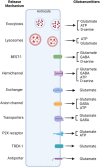Calcium signaling in astrocytes and gliotransmitter release
- PMID: 36937570
- PMCID: PMC10017551
- DOI: 10.3389/fnsyn.2023.1138577
Calcium signaling in astrocytes and gliotransmitter release
Abstract
Glia are as numerous in the brain as neurons and widely known to serve supportive roles such as structural scaffolding, extracellular ionic and neurotransmitter homeostasis, and metabolic support. However, over the past two decades, several lines of evidence indicate that astrocytes, which are a type of glia, play active roles in neural information processing. Astrocytes, although not electrically active, can exhibit a form of excitability by dynamic changes in intracellular calcium levels. They sense synaptic activity and release neuroactive substances, named gliotransmitters, that modulate neuronal activity and synaptic transmission in several brain areas, thus impacting animal behavior. This "dialogue" between astrocytes and neurons is embodied in the concept of the tripartite synapse that includes astrocytes as integral elements of synaptic function. Here, we review the recent work and discuss how astrocytes via calcium-mediated excitability modulate synaptic information processing at various spatial and time scales.
Keywords: astrocyte; calcium signaling; gliotransmission; plasticity; tripartite synapse.
Copyright © 2023 Goenaga, Araque, Kofuji and Herrera Moro Chao.
Conflict of interest statement
The authors declare that the research was conducted in the absence of any commercial or financial relationships that could be construed as a potential conflict of interest.
Figures


References
-
- Abbracchio M., Verderio C. (2006). Pathophysiological roles of P2 receptors in glial cells. Novartis Found Symp. 276 91–103. - PubMed
Publication types
Grants and funding
LinkOut - more resources
Full Text Sources
Miscellaneous

